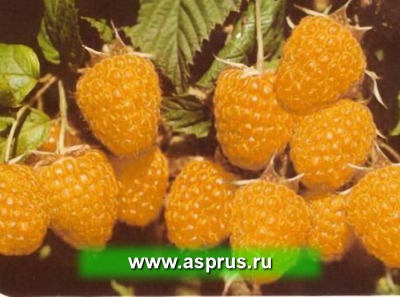
- Repairability: Yes
- Berry color: golden apricot
- Taste: dessert
- Berry weight, g: 3,0-3,5
- Yield: up to 1.5 - 2 kg per bush, or 9-11 t / ha.
- Frost resistance: medium
- Appointment: fresh consumption and for all types of processing
- Fruiting period: first decade of August and before frost
- Spike location: in the lower and middle part of the shoot
- Yield rate: high
Raspberries are grown in almost every summer cottage, since they are very useful. Choosing a tasty species with high yields, you should pay attention to the raspberry variety Apricot, which is characterized by unpretentious care, as well as a large number of useful components - iron, calcium, fructose, glucose, fiber, malic and citric acid.
Breeding history of the variety
This variety of large amber-golden berries is the result of many years of work by Russian breeders RASN Evdokimenko and Kazakov. This berry species was bred 25 years ago, but has gained wide popularity over the past few years. Included in the State Register in 2004. It is massively grown in the central regions of the country.
Description of the variety
Raspberry Apricot is a yellow-fruited variety that does not contain dyes, so babies, pregnant women, and people prone to allergic irritations can savor it fresh. The berry is characterized by large dimensions, and its bushes are slightly prickly and slightly spreading, that is, the branches are more straight-growing.
Ripening terms
Fruiting dates are a bit extended. The fruits can be tasted in the first half of August, and the harvest ends with the onset of frost. Fruiting dates may shift slightly due to the climatic features of the region.
Growing regions
The optimal place for growing and good fruiting plants are regions with not very harsh winters.
Yield
High yield variety. With proper planting and care, up to 2 kg of berries can be harvested from each bush. The plant has two harvests per season.
Berries and their taste
The berries are cone-shaped with a blunt end. On ripe fruits of a yellow-golden color, there is an edge. The weight of one berry is about 3 grams. On the palate, raspberries are quite sweet, soft, with a barely noticeable sourness. There is no pronounced aroma in the variety. The variety is excellent, but its transportability is poor.

Growing features
With the right place and proper plant care, even an inexperienced gardener can get a bountiful harvest of amber berries. A characteristic feature is that the raspberry bushes are erect and do not take up much space, therefore, huge land plots are not required for a plant.
Site selection and soil preparation
The area for planting raspberries Apricot should be well lit by the sun. As a rule, bushes are planted in a north-south direction. Loose and fertile soil is optimal for the plant. The site should not be swampy, since excess moisture in groundwater will negatively affect the root system of the plant.Before planting, the site is cleared of weeds, then thorough digging and fertilization with useful components. Preparation is carried out several weeks before planting, as the soil takes time to shrink. The optimal season for planting is autumn, however, the raspberry tree is also planted in early spring.


Pruning
Before winter, all shoots are cut off, leaving only low stumps. In early spring, the shoots are shortened by 10-15 cm, and dried branches are also cut off.

Watering and feeding
This variety requires abundant watering, but without stagnant moisture. If mulching is carried out, then watering is made more rare. Winter watering is important, when the plant is abundantly flooded with water before the onset of cold weather.
This variety of raspberries is nutritionally demanding. During the season, especially during the flowering and fruiting period, feeding is performed several times with special infusions of wood ash and mullein.


Frost resistance and preparation for winter
The plant is very frost-resistant, so there is no need to perform special warming manipulations, with the exception of watering and shortening the branches. If the region has cold winters, then the bush needs to be buried a little with earth.

Diseases and pests
The Apricot raspberry variety is very resistant to diseases and pests, but you should not forget about preventive measures.

Unfortunately, raspberries, like other plants, do not bypass various diseases and pests. Only armed with the knowledge and the necessary means for this, you can cope with such troubles. To help the plant, it is very important to be able to recognize the disease in time and begin timely treatment.
Reproduction
New bushes of raspberry Apricot can be obtained in three ways: by separating root cuttings, cutting off green shoots and taking a separate growth bud.

Review overview
Gardeners characterize this raspberry variety as unpretentious in care, but a little capricious to climatic fluctuations. Most farmers note the high yield, rich taste of the berry, which can be eaten fresh, as well as canned, frozen, and boiled compotes.
Another advantage is the compactness of the bushes, which allows you to grow berries even in a small summer cottage.







































































